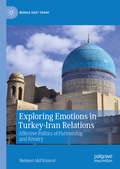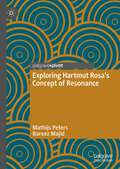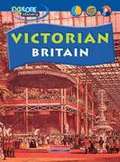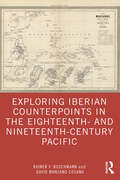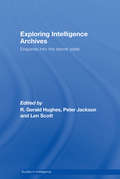- Table View
- List View
Exploring Emotions in Turkey-Iran Relations: Affective Politics of Partnership and Rivalry (Middle East Today)
by Mehmet Akif KumralThis book explores emotional-affective implications of partnership and rivalry in Turkey-Iran relations. The main proposition of this research underlines the theoretical need to reconnect psycho-social conceptualizations of “emotionality,” “affectivity,” “normativity,” and “relationality.” By combining key theoretical findings, the book offers a holistic conceptual framework to better analyze emotional-affective configuration of relational rules and roles in trans-governmental neighborhood interactions. The empirical chapters look at four consecutive periods extending from the end of First World War (November 1918) to the resuscitation of US sanctions against Iran (November 2018). In each episode, global-regional contours and dyadic dynamics of Ankara-Tehran relationship are examined critically. The century-long history of emotional entanglements and affective arrangements exposes complex patterning of “feeling rules.” Two countervailing constellations still reign over relational narratives. While the 1514 Çaldıran war myth reproduces sectarian resentment and confrontational climate, the 1639 Kasr-ı Şirin peace story reconstructs secular sympathy and collaborative atmosphere in Turkish-Iranian affairs.
Exploring Entrepreneurship: Unpacking the Mosaic of Entrepreneurship across Africa
by Hakeem Adeniyi Ajonbadi Susan Sisay Seun OladeleThis book explores the recent trends and challenges facing entrepreneurship in Africa. It features several chapters that cut across various contexts, highlighting aspects of social entrepreneurship, faith-based entrepreneurship, entrepreneurial financing, equality, diversity, inclusion, digital and technological transformation and regulations and enabling ecosystems across African countries. The chapters will be underpinned by a critical approach to understanding the trends and challenges in African entrepreneurship, which goes beyond focusing on the business cases but considers the sensitivity of the national context. The authors have a wealth of professional and academic experience. They have taught in institutions around the world and between them have worked in several managerial and entrepreneurial positions.
Exploring European Frontiers: British Travellers in the Age of Enlightenment
by B. DolanThe explorations of eighteenth-century travellers to the 'European frontiers' were often geared to define the cultural, political, and historical boundaries of 'European civilization.' In an age when political revolutions shocked nations into reassessing what separated the civilised from the barbaric, how did literary travellers contemplate the characteristics of their continental neighbours? Focusing on the writings of British travellers, we see how a new view of Europe was created, one that juxtaposed the customs and living conditions of populations in an attempt to define 'modern' Europe against a 'yet unenlightened' Europe.
Exploring Greek Manuscripts in the Library at Wellcome Collection in London
by Petros Bouras-VallianatosThis book offers new insights into a largely understudied group of Greek texts preserved in selected manuscripts from the Library at Wellcome Collection, London. The content of these manuscripts ranges from medicine, including theories on diagnosis and treatment of disease, to astronomy, philosophy, and poetry. With texts dating from the ancient era to the Byzantine and Ottoman worlds, each manuscript provides its own unique story, opening a window onto different social and cultural milieus. All chapters are illustrated with black and white and colour figures, highlighting some of the most significant codices in the collection.
Exploring Greek Manuscripts in the Library at Wellcome Collection in London
by Petros Bouras-VallianatosThis book offers new insights into a largely understudied group of Greek texts preserved in selected manuscripts from the Library at Wellcome Collection, London. The content of these manuscripts ranges from medicine, including theories on diagnosis and treatment of disease, to astronomy, philosophy, and poetry. With texts dating from the ancient era to the Byzantine and Ottoman worlds, each manuscript provides its own unique story, opening a window onto different social and cultural milieus. All chapters are illustrated with black and white and colour figures, highlighting some of the most significant codices in the collection.
Exploring Greenland: Cold War Science and Technology on Ice (Palgrave Studies in the History of Science and Technology)
by Ronald E. Doel Kristine C. Harper Matthias HeymannUsing newly declassified documents, this book explores why U.S. military leaders after World War II sought to monitor the far north and understand the physical environment of Greenland, a crucial territory of Denmark. It reveals a fascinating yet little-known realm of Cold War intrigue and a delicate diplomatic duet between a smaller state and a superpower amid a time of intense global pressures. Written by scholars in Denmark and the United States, this book explores many compelling topics. What led to the creation of the U.S. Thule Air Base in Greenland, one of the world’s largest, and why did the U.S. build a nuclear-powered city under Greenland’s ice cap? How did Danish concern about sovereignty shape scientific research programs in Greenland? Also explored here: why did Denmark’s most famous scientist, Inge Lehmann, became involved in research in Greenland, and what international reverberations resulted from the crash of a U.S. B-52 bomber carrying four nuclear weapons near Thule in January 1968?
Exploring Gregory of Nyssa: Philosophical, Theological, and Historical Studies
by Anna Marmodoro Neil B. McLynnExploring Gregory of Nyssa: Philosophical, Theological, and Historical Studies brings together an interdisciplinary team of historians, classicists, philosophers, and theologians to offer a holistic exploration of the thought of Gregory of Nyssa. The volume considers Gregory's role in the main philosophical and religious controversies of his era, such as his ecclesiastical involvement in the Neo-Nicene apologetical movement. It looks at his complex relationships-for example with his brother Basil of Caesarea and with Gregory of Nazianzus. Contributors highlight Gregory's debt to Origen, but also the divergence between the two thinkers, and their relationships to Platonism. They also examine Gregory of Nyssa's wider philosophy and metaphysics; deep questions in philosophy of language such as the nature of predication and singular terms that inform our understanding of Gregory's thought; and the role of metaphysical concepts such as the nature of powers and identity. The study paints a picture of Gregory as a ground-breaking philosopher-theologian. It analyses the nature of the soul, and connection to theological issues such as resurrection; questions that are still of interest in the philosophy of religion today, such as divine impassibility and the nature of the Trinity; and returning to more immediately humane concerns, Gregory also has profound thoughts on topics such as vulnerability and self-direction. The volume will be of primary interest to researchers, lecturers, and postgraduate students in philosophy, classics, history, and theology, and can be recommended as secondary reading for undergraduates, especially those studying classics and theology.
Exploring Gregory of Nyssa: Philosophical, Theological, and Historical Studies
Exploring Gregory of Nyssa: Philosophical, Theological, and Historical Studies brings together an interdisciplinary team of historians, classicists, philosophers, and theologians to offer a holistic exploration of the thought of Gregory of Nyssa. The volume considers Gregory's role in the main philosophical and religious controversies of his era, such as his ecclesiastical involvement in the Neo-Nicene apologetical movement. It looks at his complex relationships-for example with his brother Basil of Caesarea and with Gregory of Nazianzus. Contributors highlight Gregory's debt to Origen, but also the divergence between the two thinkers, and their relationships to Platonism. They also examine Gregory of Nyssa's wider philosophy and metaphysics; deep questions in philosophy of language such as the nature of predication and singular terms that inform our understanding of Gregory's thought; and the role of metaphysical concepts such as the nature of powers and identity. The study paints a picture of Gregory as a ground-breaking philosopher-theologian. It analyses the nature of the soul, and connection to theological issues such as resurrection; questions that are still of interest in the philosophy of religion today, such as divine impassibility and the nature of the Trinity; and returning to more immediately humane concerns, Gregory also has profound thoughts on topics such as vulnerability and self-direction. The volume will be of primary interest to researchers, lecturers, and postgraduate students in philosophy, classics, history, and theology, and can be recommended as secondary reading for undergraduates, especially those studying classics and theology.
Exploring Hartmut Rosa's Concept of Resonance
by Mathijs Peters Bareez MajidThis book makes a compelling case for utilising experiences of resonance in various academic and societal fields. The concept of resonance was first introduced by Hartmut Rosa to foreground the importance of affective, emotional, transformative and uncontrollable experiences in socio-political contexts that he characterizes as alienating. Based on a critical reading of Rosa’s theory and further developed through engagement with Theodor W. Adorno, Gilles Deleuze, Hannah Arendt, Judith Butler and others, this book introduces the notion of a ‘spectrum of resonance’ which encompasses both critical resonance and affirmationist resonance. This spectrum of resonance is used to analyse various forms of aesthetic experience illustrated with reference to Edgar Reitz’s film Heimat and the music of Nick Cave and Kayhan Kalhor. The spectrum is also deployed in the fields of museum, memory and trauma studies to show how experiences of resonance contribute to the constitution of political and social identities. The focus here is on memory practices in the Kurdistan Region of Iraq and the book seeks to decolonize resonance theory.
Exploring Historical Cambridgeshire
by Robert LeaderThis fascinating and beautifully photographed guidebook follows Cambridgeshire’s waterways from leafy Huntingdon to the wide-sky Fens, along the lovely Nene Valley down to the busy port town of Wisbech and travels beside the gentle stream of the Cam into the architectural glories of the university city of Cambridge. The narrative explores the history of Cambridgeshire through its vanished castles and abbeys, and traces the draining of the wild marshes. Cambridgeshire is a county that is different to any other in England, and the watery landscapes of the Fens are unique. From the bizarre Straw Bears that lead the hosts of morris dancers through the heart of Whittlesey every January, to the sedate Rose Fair that graces Wisbech church and gardens every June, Cambridgeshire has something to offer everyone.
Exploring History: Victorian Britain (PDF)
by Jane ShuterThis series gives easy-to-use support for the QCA Scheme of Work for history at KS2. It poses a question about an aspect of history and then answers it with the help of written and pictorial primary sources.
Exploring Iberian Counterpoints in the Eighteenth- and Nineteenth-Century Pacific
by Rainer F. Buschmann David Manzano CosanoThrough a number of significant case studies, this volume examines changing Iberian dynamics in the Pacific, bridging the gaps between English and Spanish speaking scholarship to highlight understudied actors and debates in the eighteenth and nineteenth centuries. The book shifts the predominant emphasis on Anglo-American studies and the historical neglect of Iberian endeavors in this ocean by focusing on several episodes that illuminate Spanish engagement in the Pacific. It describes Spain’s treatment of this sea from its discovery to the end of the overseas empire in 1899, becoming the first book to place its analytical focus in the heart of the islands rather than the Pacific Rim. In tracing shifting Spanish positions and policies, the book cautions against making generalities about the distinct histories of Pacific islands and their Indigenous populations, uncovering a much more heterogeneous world than previous research may convey. Exploring Iberian Counterpoints in the Eighteenth- and Nineteenth-Century Pacific is the perfect resource for students and researchers of the Iberian world, Hispanic studies, and the Pacific Ocean in early modern and modern eras.
Exploring Iberian Counterpoints in the Eighteenth- and Nineteenth-Century Pacific
by Rainer F. Buschmann David Manzano CosanoThrough a number of significant case studies, this volume examines changing Iberian dynamics in the Pacific, bridging the gaps between English and Spanish speaking scholarship to highlight understudied actors and debates in the eighteenth and nineteenth centuries. The book shifts the predominant emphasis on Anglo-American studies and the historical neglect of Iberian endeavors in this ocean by focusing on several episodes that illuminate Spanish engagement in the Pacific. It describes Spain’s treatment of this sea from its discovery to the end of the overseas empire in 1899, becoming the first book to place its analytical focus in the heart of the islands rather than the Pacific Rim. In tracing shifting Spanish positions and policies, the book cautions against making generalities about the distinct histories of Pacific islands and their Indigenous populations, uncovering a much more heterogeneous world than previous research may convey. Exploring Iberian Counterpoints in the Eighteenth- and Nineteenth-Century Pacific is the perfect resource for students and researchers of the Iberian world, Hispanic studies, and the Pacific Ocean in early modern and modern eras.
Exploring Intelligence Archives: Enquiries into the Secret State (Studies in Intelligence)
by R. Gerald Hughes Peter Jackson Len ScottThis edited volume brings together many of the world’s leading scholars of intelligence with a number of former senior practitioners to facilitate a wide-ranging dialogue on the central challenges confronting students of intelligence. The book presents a series of documents, nearly all of which are published here for the first time, accompanied by both overview and commentary sections. The central objectives of this collection are twofold. First, it seeks to build on existing scholarship on intelligence in deepening our understanding of its impact on a series of key events in the international history of the past century. Further, it aims to explore the different ways in which intelligence can be studied by bringing together both scholarly and practical expertise to examine a range of primary material relevant to the history of intelligence since the early twentieth century. This book will be of great interest to students of intelligence, strategic and security studies, foreign policy and international history.
Exploring Intelligence Archives: Enquiries into the Secret State (Studies in Intelligence)
by R. Gerald Hughes Peter Jackson Len ScottThis edited volume brings together many of the world’s leading scholars of intelligence with a number of former senior practitioners to facilitate a wide-ranging dialogue on the central challenges confronting students of intelligence. The book presents a series of documents, nearly all of which are published here for the first time, accompanied by both overview and commentary sections. The central objectives of this collection are twofold. First, it seeks to build on existing scholarship on intelligence in deepening our understanding of its impact on a series of key events in the international history of the past century. Further, it aims to explore the different ways in which intelligence can be studied by bringing together both scholarly and practical expertise to examine a range of primary material relevant to the history of intelligence since the early twentieth century. This book will be of great interest to students of intelligence, strategic and security studies, foreign policy and international history.
Exploring Ireland’s Viking-Age Towns: Houses and Homes (Routledge Archaeologies of the Viking World)
by Rebecca BoydExploring Ireland’s Viking-Age Towns discusses the emergence of towns, urban lifestyles, and urban identities in Ireland. This coincides with the arrival of the Vikings and the appearance of the post-and-wattle Type 1 house. These houses reflect this crucial transition to urban living with its attendant changes for individuals, households, and society. Exploring Ireland’s Viking-Age Towns uses household archaeology as a lens to explore the materiality, variability, and day-to-day experiences of living in these houses. It moves from the intimate scale of individual households to the larger scale of Ireland’s earliest urban communities. For the first time, this book considers how these houses were more than just buildings: they were homes, important places where people lived, worked, and died. These new towns were busy places with a multitude of people, ideas, and things. This book uses the mass of archaeological data to undertake comparative analyses of houses and properties, artefact distribution patterns, and access analysis studies to interrogate some 500 Viking-Age urban houses. This analysis is structured in three parts: an investigation of the houses, the households, and the town. Exploring Ireland’s Viking-Age Towns discusses how these new urban households managed their homes to create a sense of place and belonging in these new environments and allow themselves to develop a new, urban identity. This book is suited to advanced students and specialists of the Viking Age in Ireland, but archaeologists and historians of the early medieval and Viking worlds will find much of interest here. It will also appeal to readers with interests in the archaeology of house and home, households, identities, and urban studies.
Exploring Ireland’s Viking-Age Towns: Houses and Homes (Routledge Archaeologies of the Viking World)
by Rebecca BoydExploring Ireland’s Viking-Age Towns discusses the emergence of towns, urban lifestyles, and urban identities in Ireland. This coincides with the arrival of the Vikings and the appearance of the post-and-wattle Type 1 house. These houses reflect this crucial transition to urban living with its attendant changes for individuals, households, and society. Exploring Ireland’s Viking-Age Towns uses household archaeology as a lens to explore the materiality, variability, and day-to-day experiences of living in these houses. It moves from the intimate scale of individual households to the larger scale of Ireland’s earliest urban communities. For the first time, this book considers how these houses were more than just buildings: they were homes, important places where people lived, worked, and died. These new towns were busy places with a multitude of people, ideas, and things. This book uses the mass of archaeological data to undertake comparative analyses of houses and properties, artefact distribution patterns, and access analysis studies to interrogate some 500 Viking-Age urban houses. This analysis is structured in three parts: an investigation of the houses, the households, and the town. Exploring Ireland’s Viking-Age Towns discusses how these new urban households managed their homes to create a sense of place and belonging in these new environments and allow themselves to develop a new, urban identity. This book is suited to advanced students and specialists of the Viking Age in Ireland, but archaeologists and historians of the early medieval and Viking worlds will find much of interest here. It will also appeal to readers with interests in the archaeology of house and home, households, identities, and urban studies.
Exploring Life Phenomena with Statistical Mechanics of Molecular Liquids
by Fumio HirataIn a living body, a variety of molecules are working in a concerted manner to maintain its life, and to carry forward the genetic information from generation to generation. A key word to understand such processes is "water," which plays an essential role in life phenomena. This book sheds light on life phenomena, which are woven by biomolecules as warp and water as weft, by means of statistical mechanics of molecular liquids, the RISM and 3D-RISM theories, both in equilibrium and non-equilibrium. A considerable number of pages are devoted to basics of mathematics and physics, so that students who have not majored in physics may be able to study the book by themselves. The book will also be helpful to those scientists seeking better tools for the computer-aided-drug-discovery. Explains basics of the statistical mechanics of molecular liquids, or RISM and 3D-RISM theories, and its application to water. Provides outline of the generalized Langevin theory and the linear response theory, and its application to dynamics of water. Applies the theories to functions of biomolecular systems. Applies the theories to the computer aided drug design. Provides a perspective for future development of the method.
Exploring Life Phenomena with Statistical Mechanics of Molecular Liquids
by Fumio HirataIn a living body, a variety of molecules are working in a concerted manner to maintain its life, and to carry forward the genetic information from generation to generation. A key word to understand such processes is "water," which plays an essential role in life phenomena. This book sheds light on life phenomena, which are woven by biomolecules as warp and water as weft, by means of statistical mechanics of molecular liquids, the RISM and 3D-RISM theories, both in equilibrium and non-equilibrium. A considerable number of pages are devoted to basics of mathematics and physics, so that students who have not majored in physics may be able to study the book by themselves. The book will also be helpful to those scientists seeking better tools for the computer-aided-drug-discovery. Explains basics of the statistical mechanics of molecular liquids, or RISM and 3D-RISM theories, and its application to water. Provides outline of the generalized Langevin theory and the linear response theory, and its application to dynamics of water. Applies the theories to functions of biomolecular systems. Applies the theories to the computer aided drug design. Provides a perspective for future development of the method.
Exploring Mishnah's World(s): Social Scientific Approaches
by Simcha Fishbane Calvin Goldscheider Jack N. LightstoneThis book provides a new conceptual and methodological framework the social scientific study of Mishnah, as well as a series of case studies that apply social science perspectives to the analysis of Mishnah's evidence. The framework is one that takes full account of the historical and literary-historical issues that impinge upon the use of Mishnah for any scholarly purposes beyond philological study, including social scientific approaches to the materials. Based on the framework, each chapter undertakes, with appropriate methodological caveats, an avenue of inquiry open to the social scientist that brings to bear social scientific questions and modes of inquiry to Mishnaic evidence.
Exploring Morality and Sexuality in Asian Cinema: Cinematic Boundaries
by Peter C. PugsleyThis ground-breaking book explores the moral dimensions of sexual imagery in contemporary, general-release Asian films. It examines debates that arise over aesthetic styles and the cultural and traditional influences that determine the content and impact of these films. The social and regulatory environments for filmmakers across Asia reflect distinct national and cultural differences. In just the past decade, for instance, Indian cinema has rapidly moved from representations of coy and submissive female protagonists to highly eroticized leading ladies unafraid of flaunting their sexuality. On the other hand, the cinema emerging from the Chinese mainland has been much more circumspect in its representations of overt sexuality, at times in conflict with other Chinese cinemas from Hong Kong and Taiwan. This use of sexual imagery or morally questionable film content raises on-going debates into censorship and the use of state or industry controls to protect certain sectors of society from exposure to particular narratives or images. Film, like all forms of art, fulfils a number of aesthetic functions for local, regional and international audiences. As distribution and technological advances make Asian films more readily available across the globe, an understanding of the different aesthetics at play will enable readers of this book to recognize key cultural motifs in representations of onscreen sexuality and the surrounding controversies found in cinematic texts from Asia.
Exploring Morality and Sexuality in Asian Cinema: Cinematic Boundaries
by Peter C. PugsleyThis ground-breaking book explores the moral dimensions of sexual imagery in contemporary, general-release Asian films. It examines debates that arise over aesthetic styles and the cultural and traditional influences that determine the content and impact of these films. The social and regulatory environments for filmmakers across Asia reflect distinct national and cultural differences. In just the past decade, for instance, Indian cinema has rapidly moved from representations of coy and submissive female protagonists to highly eroticized leading ladies unafraid of flaunting their sexuality. On the other hand, the cinema emerging from the Chinese mainland has been much more circumspect in its representations of overt sexuality, at times in conflict with other Chinese cinemas from Hong Kong and Taiwan. This use of sexual imagery or morally questionable film content raises on-going debates into censorship and the use of state or industry controls to protect certain sectors of society from exposure to particular narratives or images. Film, like all forms of art, fulfils a number of aesthetic functions for local, regional and international audiences. As distribution and technological advances make Asian films more readily available across the globe, an understanding of the different aesthetics at play will enable readers of this book to recognize key cultural motifs in representations of onscreen sexuality and the surrounding controversies found in cinematic texts from Asia.
Exploring Nanosyntax (Oxford Studies in Comparative Syntax)
Exploring Nanosyntax provides the first in-depth introduction to the framework of nanosyntax, which originated in the early 2000s as a formal theory of language within Principles and Parameters framework. Deploying a radical implementation of the cartographic "one feature - one head" maxim, the framework provides a fine-grained decomposition of morphosyntactic structure, laying bare the building blocks of the universal functional sequence. This volume makes three contributions: First, it presents the framework's constitutive tools and principles, and explains how nanosyntax relates to cartography and to Distributed Morphology. Second, it illustrates how nanosyntactic tools and principles can be applied to a range of empirical domains of natural language. In doing so, the volume provides a range of detailed crosslinguistic investigations which uncover novel empirical data and which contribute to a better understanding of the functional sequence. Third, specific problems are raised and discussed and new theoretical strands internal to the nanosyntactic framework are explored. Bringing together original contributions by senior and junior researchers in the field, Exploring Nanosyntax offers the first all-encompassing view of this promising framework, making its methodology and exciting results accessible to a wide audience.
EXPLORING NANOSYNTAX OSCS C (Oxford Studies in Comparative Syntax)
by Lena Baunaz, Karen De Clercq, Liliane Haegeman, and Eric LanderExploring Nanosyntax provides the first in-depth introduction to the framework of nanosyntax, which originated in the early 2000s as a formal theory of language within Principles and Parameters framework. Deploying a radical implementation of the cartographic "one feature - one head" maxim, the framework provides a fine-grained decomposition of morphosyntactic structure, laying bare the building blocks of the universal functional sequence. This volume makes three contributions: First, it presents the framework's constitutive tools and principles, and explains how nanosyntax relates to cartography and to Distributed Morphology. Second, it illustrates how nanosyntactic tools and principles can be applied to a range of empirical domains of natural language. In doing so, the volume provides a range of detailed crosslinguistic investigations which uncover novel empirical data and which contribute to a better understanding of the functional sequence. Third, specific problems are raised and discussed and new theoretical strands internal to the nanosyntactic framework are explored. Bringing together original contributions by senior and junior researchers in the field, Exploring Nanosyntax offers the first all-encompassing view of this promising framework, making its methodology and exciting results accessible to a wide audience.
Exploring Nationalisms of China: Themes and Conflicts (Contributions to the Study of World History)
by C. X. George Wei Xiaoyuan LiuChina is a site for the evolution, not only of Chinese nationalism, but the nationalism of various non-Han ethnic groups. During the 20th century, these ethnic groups constructed and expressed their own identities and nationalism through interaction with one another and with outside influences. This interdisciplinary anthology contains nine original works that pluralize our understanding of nationalism in China by illustrating the various intellectual strains of China's nationalist discourse, the dichotomy between the political authorities' and grass roots' experiences, and the nationalizing efforts by various ethnic and political groups along China's inland and maritime frontiers.First, contributors explore the controversy surrounding the contested issue of China's national and international identity from pre-modern times to the present. Next, the authors examine China's nationalist encounters with foreign influences such as U.S. Marines in Shandong, Soviet experts in Manchuria, and recent friction between the United States and the PRC. Finally, essays expand beyond the ethnographic regions of the Han-Chinese and the political domain of the PRC to discuss the odyssey of Taiwan's nationalism in both a political and a cultural sense. Many selections are based on newly declassified archival materials.
